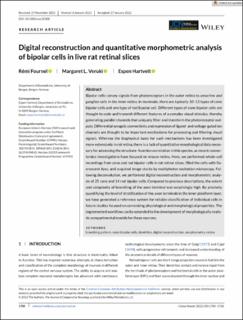| dc.contributor.author | Fournel, Rémi | |
| dc.contributor.author | Veruki, Margaret Lin | |
| dc.contributor.author | Hartveit, Espen | |
| dc.date.accessioned | 2022-04-22T08:52:51Z | |
| dc.date.available | 2022-04-22T08:52:51Z | |
| dc.date.created | 2022-02-07T13:22:28Z | |
| dc.date.issued | 2022 | |
| dc.identifier.issn | 0021-9967 | |
| dc.identifier.uri | https://hdl.handle.net/11250/2992173 | |
| dc.description.abstract | Bipolar cells convey signals from photoreceptors in the outer retina to amacrine and ganglion cells in the inner retina. In mammals, there are typically 10–15 types of cone bipolar cells and one type of rod bipolar cell. Different types of cone bipolar cells are thought to code and transmit different features of a complex visual stimulus, thereby generating parallel channels that uniquely filter and transform the photoreceptor outputs. Differential synaptic connectivity and expression of ligand- and voltage-gated ion channels are thought to be important mechanisms for processing and filtering visual signals. Whereas the biophysical basis for such mechanisms has been investigated more extensively in rat retina, there is a lack of quantitative morphological data necessary for advancing the structure–function correlation in this species, as recent connectomics investigations have focused on mouse retina. Here, we performed whole-cell recordings from cone and rod bipolar cells in rat retinal slices, filled the cells with fluorescent dyes, and acquired image stacks by multiphoton excitation microscopy. Following deconvolution, we performed digital reconstruction and morphometric analysis of 25 cone and 14 rod bipolar cells. Compared to previous descriptions, the extent and complexity of branching of the axon terminal was surprisingly high. By precisely quantifying the level of stratification of the axon terminals in the inner plexiform layer, we have generated a reference system for reliable classification of individual cells in future studies focused on correlating physiological and morphological properties. The implemented workflow can be extended to the development of morphologically realistic compartmental models for these neurons. | en_US |
| dc.language.iso | eng | en_US |
| dc.publisher | Wiley | en_US |
| dc.rights | Attribution-NonCommercial-NoDerivatives 4.0 Internasjonal | * |
| dc.rights.uri | http://creativecommons.org/licenses/by-nc-nd/4.0/deed.no | * |
| dc.title | Digital reconstruction and quantitative morphometric analysis of bipolar cells in live rat retinal slices | en_US |
| dc.type | Journal article | en_US |
| dc.type | Peer reviewed | en_US |
| dc.description.version | publishedVersion | en_US |
| dc.rights.holder | Copyright 2022 The Author(s) | en_US |
| cristin.ispublished | false | |
| cristin.fulltext | original | |
| cristin.qualitycode | 1 | |
| dc.identifier.doi | 10.1002/cne.25308 | |
| dc.identifier.cristin | 1998580 | |
| dc.source.journal | Journal of Comparative Neurology | en_US |
| dc.source.pagenumber | 1700-1728 | |
| dc.relation.project | Norges forskningsråd: 261914 | en_US |
| dc.relation.project | EC/H2020/674901 | en_US |
| dc.relation.project | Norges forskningsråd: 182743 | en_US |
| dc.relation.project | Norges forskningsråd: 214216 | en_US |
| dc.relation.project | Norges forskningsråd: 189662 | en_US |
| dc.identifier.citation | Journal of Comparative Neurology. 2022, 530 (10), 1700-1728. | en_US |
| dc.source.volume | 530 | |
| dc.source.issue | 10 | |

